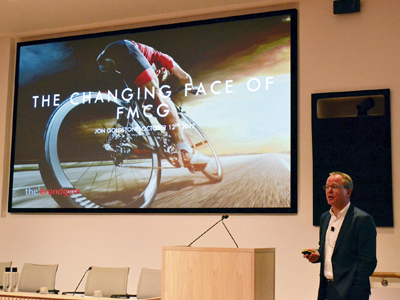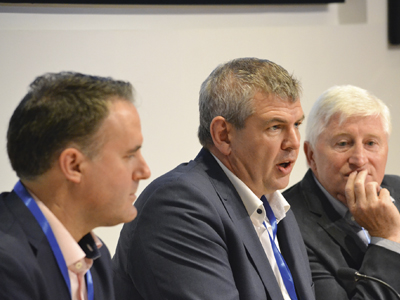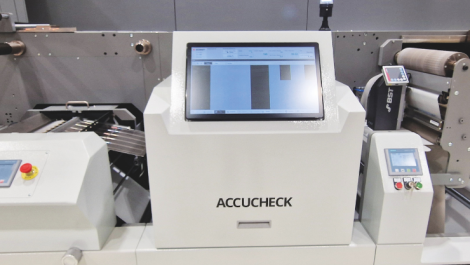Discussing the real value of digital print
Almost 100 delegates came to London on 12 October to learn about the opportunities for digital print in packaging and hear first-hand accounts from the expert speakers, which included brands, retailers, designers and printers.
Now in its fourth year, the Digital Print for Brand Success conference continues to provide a unique space for all parts of the value chain to come together to take stock of the achievements and new innovations in digital print for labels and packaging.
‘We are talking about the three Ts: thought leadership, trends and technology,’ said chair Neel Madsen. ‘While digital print continues to be in focus, it was clear from Labelexpo that we are moving away from just discussing the Technology and that it is the Trends that are in focus. And we, or rather our speakers, are here to provide the Thought leadership.’
Shift from big players
Keynote speaker Jon Goldstone, global managing partner at the brandgym, described the FMCG market today, saying that the way back into profit for big brands that have lost market share is to take their clues from smaller challenger brands. ‘A lot has changed since I worked on the ‘Go on Lad’ Hovis campaign for Premier Foods 10 years ago,’ he said. ‘The formula was simple then: achieve penetration growth, gain bigger share of the market and watch the sales grow, but Hovis was the last CPG [consumer packaged goods] brand to win the IPA Effectiveness Grand Prix.’

Keynote speaker Jon Goldstone
He highlighted examples of start-up brands that have successfully taken a significant share of the market from the big names, including Fever-Tree mixer drinks, Clipper tea and Pip & Nut spreads. He also spoke about the big disruption taking place in retail with the big five supermarket chains declining, and the way consumers shop using different channels, such as e-commerce, saying the FMCG brands are facing ‘the perfect storm’.
The market response has been to set higher growth targets and cut costs, but he warned that we are in danger of entering ‘the doom loop’ where zero-based budgeting (which starts from zero at the beginning of each financial year with each department having to justify any expenditure) is leading to lower investment and poor brand health.
Marketing has not fared much better according to a survey carried out by the brandgym that showed real strategy is giving way to keeping up with the latest trends; 62% of marketing directors agreed that ‘with all the focus on digital/social media today, strategy gets overlooked.’
Challenger brands offer high quality, a clear proposition and social relevance, explained Mr Goldstone. They are most often run by a small enthusiastic team of people who are doing ‘really cool stuff’. They understand how to make consumers love the brand and want to take a picture to share online, where big brands often make this feel awkward
and contrived.
While most FMCG brands are struggling, there are some success stories however where breakthrough ideas have successfully been implemented. The packaging industry can help, said Mr Goldstone, by solving strategic issues and overcome the on-cost perception. Even so, his prediction is that the number of challenger brands will accelerate as the barriers to entry is now so low and the situation is one where it is the big retailers coming to the small brands with offers. He concluded, ‘A lot of the big FMCG brands won’t be here in 10 years.’
Packaging trends
Real life examples of great campaigns that have used digital print to reach consumers in new and innovative ways were analysed by ThePackHub’s founder Paul Jenkins. He took the delegates on a whirlwind tour of some of his favourites and discussed the main trends behind the designs.
Speaking about the impact that technological developments in packaging print has had, he said, ‘It would have been difficult for me to do this presentation just four or five years ago, but the rise in digital print has completely changed the market.’
Examples of the ‘made for me’ trend include personalisation campaigns such as Marmite jars, Smirnoff limited edition Vodka bottles, Firefly juice bottles, KitKat chocolate and Onken yogurt. Other versioning campaigns highlighted were Nutella jars and Diet Coke bottles with unique art designs; all enabled by digital print technology. Mr Jenkins concluded, ‘The outlook for digital print is bright as it is now a viable alternative to conventional print and can play in many more areas.’

The Printers’ Panel shared their views and experiences
Immediately following, Mr Jenkins facilitated a panel discussion with Brian Stow, who is packaging innovation technical leader at Mars Chocolate UK, Jason Gilmartin, senior packaging print manager at ASDA, John Nicholson, HAVI senior manager packaging development and innovation, and Guy Douglass, who is creative strategy director at Parker Williams, which is part of Sun Branding Solutions.
The panel spoke about their experiences with digital print and what challenges they have encountered. Mr Gilmartin said that ASDA is still not using digital for its own brand packaging and that implementing it will add even more complexity to an already very complex supply chain. Mr Stow cited costs as the main barrier, saying, ‘We need an ongoing programme not just single solutions, but the challenge is where to start.’ Mr Nicholson mentioned having used digital quite successfully during his time at Twinings, but that the supply chain at his current client cannot accommodate digital. Mr Douglass said that digital is perceived as playing a minor role by designers, but if used right it can offer more than just personalised packaging. With questions and valuable input from the audience, the debate continued for some time. It seems clear that there are still a lot of barriers to break down in the system.
Digital journeys
‘Am I insightful, innovative or just insane?’ asked Jason Short, chairman of Qualvis Print & Packaging at the start of his talk on how the litho printing company had added two full digital production lines for folding cartons last year. ‘It may be any or all of the above, but I knew that in order to survive we needed to diversify and invest,’ he explained.
In just one year, digital has opened doors to global brands and given Qualvis a level of exposure it has not had before. It has also given its customers opportunities to enter new markets and increase their brand awareness in new and innovative ways. As an example, Mr Short shared how the very simple idea of printing Ed Sheeran’s name onto a small number of Border Biscuits packs and sending them to the singer, who then tweeted a picture, had resulted in the Scottish manufacturer increasing its market share significantly, including into new overseas markets. ‘It was a little bit of fun and it was low cost, but it had a big impact,’ he said. ‘These types of quirky ideas are great for increasing a brand’s exposure, but digital needs to become a mainstream technology, otherwise we end up as a marketing team not a manufacturer.’
An educational talk on food packaging and migration issues came from Joanna Griffiths, packaging technical manager at BRC Global Standards. She explained that it was the lack of guidance on migration that prompted The British Retail Consortium to develop its own publication. Her advice for good practice was to ‘get everyone in the room at the start of product development’ to avoid problems down the line.
The Printers’ Panel picked up the discussion as Simon Smith (CS Labels), Stuart Kellock (Label Apeel) and Tom Allum (Abbey Labels) debated topics including engagement with end users, educating the customer about digital and adding value. They also offered their feedback from Labelexpo.
Getting smarter
Richard Jones, executive creative director, Landor Associates, talked about packaging as an expression of the brand and how it creates an emotional bond as a best case scenario. ‘We like to believe we make rational choices but we don’t,’ he stated. ‘Brands such as Apple have managed to create an experience that creates an emotional bond.’ He discussed the use of technology for smart and intelligent packaging showing examples of successful implementations and some that have fared less well, saying, ‘Digital print allows us to make these interactions even more personal at quite a fast pace, but they should deliver something that goes beyond what the existing packaging already does.

Richard Jones, Landor Associates
‘We must consider wether we are making the brand experience better or whether we are just using technology because we can,’ he warned. ‘The opportunities for creating ties with the brand through packaging are massive, however, we need to make sure it is for the benefit of the people buying it.’
The view from across the Channel came from Jack Willemsz, owner of Dutch printing company, W&R Etiketten, which is part of the Optimum Group of five printing companies that together cover a wide variety of printing technology. The €12.5 million turnover company entered digital in 2012 to meet demands for shorter runs and quickly realised that managing the workflow of the many jobs was a major challenge. ‘We needed to connect our pre-press and MIS with the press,’ said Mr Willemsz. ‘It was clear that the old system had to change and we created a new automated workflow. The information should be in the system not with the staff.’ Taking this one step further, W&R installed a web-to-print system connecting customers to the workflow and ‘let them do the work.’ Mr Willemsz said, ‘You have to present this new way of working
as a benefit to the customer. If it seems like hard work to them, they
won’t participate.’
Adding value through innovation was the headline of two presentations from Kurz UK and Infigo Software. During the day, Simon Rumble from Kurz UK had offered delegates the chance to try a virtual reality packaging experience and he talked about the opportunities digital embellishment offers compared to traditional methods of foiling. Douglas Gibson, managing director of Infigo, talked about how the company’s software is enabling faster, more elegant web-to-print interfaces to deliver brand campaigns.
The ultimate goal
Making the pack king is the goal for Ultimate Group. As the last speaker of the day, executive director Chris Tonge engaged the attendees with his talk on how the company has implemented digital as a complement to flexo. He said, ‘Digital is a big part of the future and I have enjoyed the last five years in print more than my whole working life. I’m now talking to marketing teams and NPD, not procurement, about what we can do for the brand.’
With digital opening up new markets, new brands and new ways of working, Ultimate is moving away from just being a printer to offering a full packaging management experience, linked through its proprietary software. The company is also about to launch an app that will connect to the workflow and can be branded to the customer. Mr Tonge’s prediction is that digital will grow to around 30% of the market by 2025, and move from a complementary to a replacement technology.
The debate continued in the library over a drink as the delegates gathered at the end of the day. Speakers and attendees were in agreement over the positive outcome. ‘The presentations were relevant and informative for anyone wanting to learn more about digital print and what it can bring to brands and the supply chain,’ said Gregory Bentley from Coca-Cola. He added, ‘The panel discussions were also a highlight for me as the conversations were passionate, informed and covered up to date and real topics.
‘Seeing what other brands and categories are doing with digital print to grow their business and engage with their consumers is always good inspiration and food for thought,’ Mr Bentley concluded.
‘I thoroughly enjoyed presenting at the Digital Print for Brand Success conference,’ commented Mr Goldstone. ‘It was an extremely knowledgeable and welcoming crowd, and I feel that I learned just as much as I was able to share.’ Mr Jenkins described the event as ‘a great opportunity to keep up to speed with the latest digital print for packaging thought-leadership.’
Read the full November/December issue of Digital Labels & Packaging here. Subscribe to the magazine for free – register your details here.






